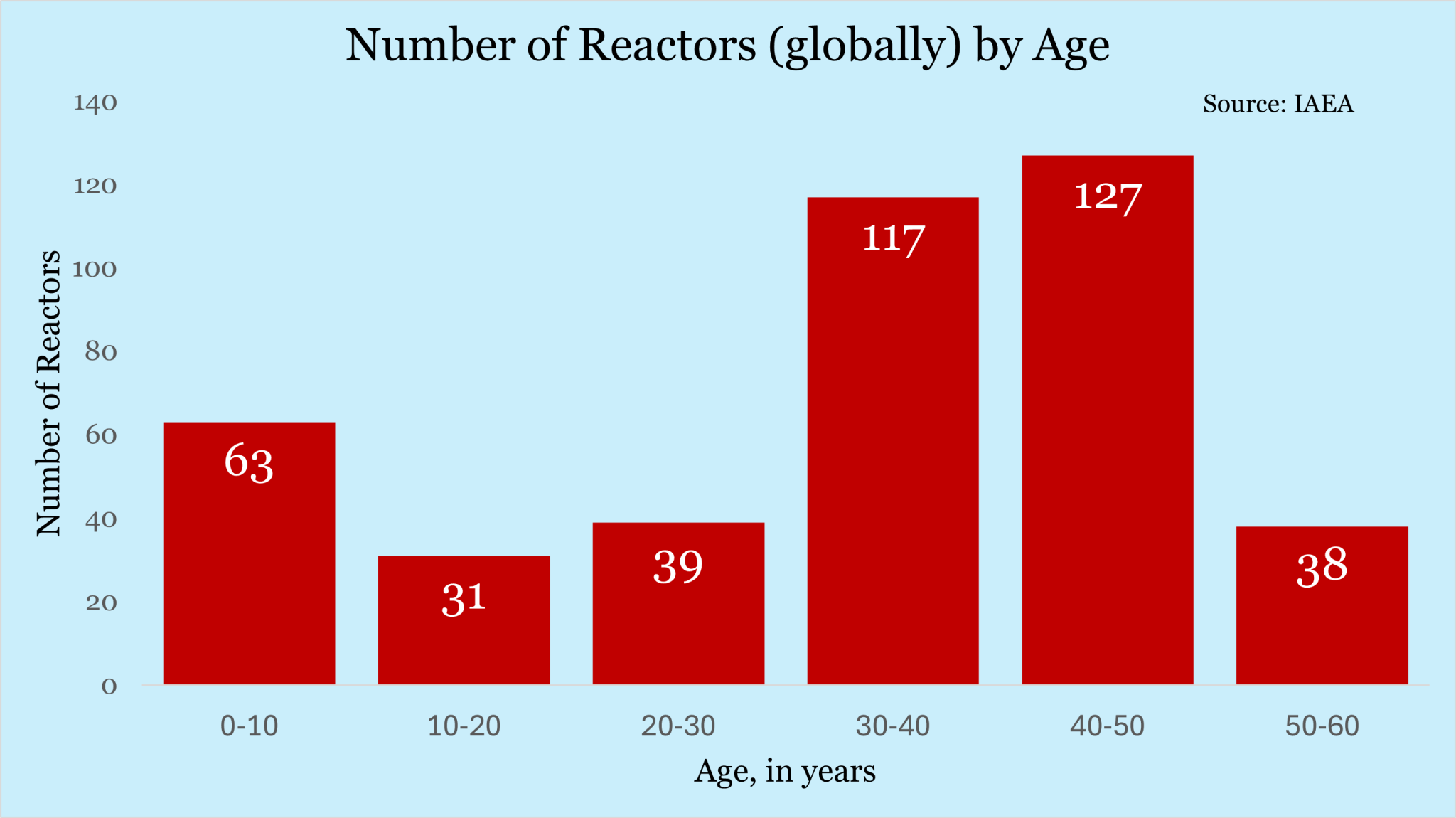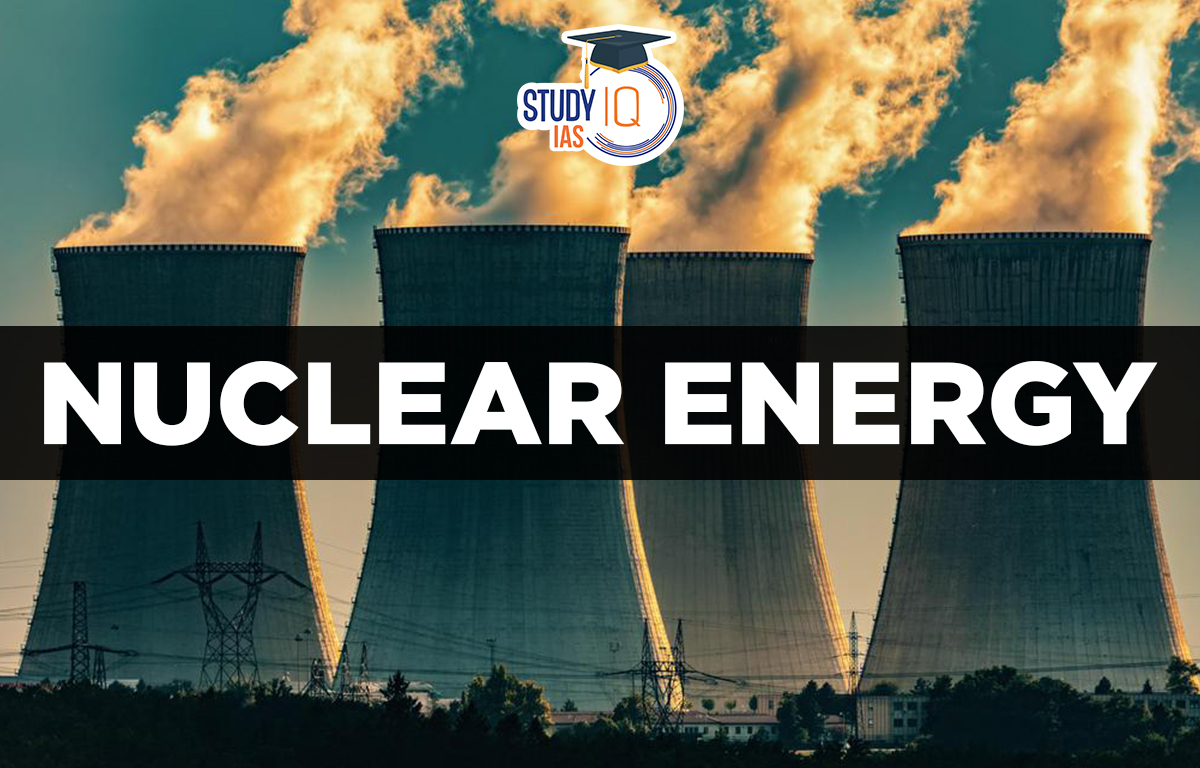Table of Contents
Context: Recently, Brussels hosted a first-of-its-kind Nuclear Energy Summit that highlighted the importance of nuclear energy as a solution to global problems like climate change and energy security.
|
Nuclear Energy Summit in Brussels |
|
What is Nuclear Energy?
Nuclear energy comes from the core of an atom, which is the tiny part that makes up everything around us. There is a lot of energy in this core, held together by something called the “strong force.” Nuclear power plants harness this energy to generate electricity for homes and businesses.
To use nuclear energy for electricity, we need to release it by splitting atoms in a process called nuclear fission. A nuclear reactor, or power plant, has machines that control this splitting to produce electricity. The fuel used in reactors is small pellets made from uranium. When uranium atoms are split they release tiny particles that cause more uranium atoms to break, creating a chain reaction. This reaction produces a lot of heat.
Uranium is the most widely used mineral for generating nuclear energy. The place where the process of nuclear fission takes place to generate electricity is called a nuclear power plant. Nuclear energy is considered a non-renewable energy source. This is because the materials used to generate nuclear energy are exhaustible.
Current Nuclear Energy Landscape
- Use: Only 31 countries currently use nuclear energy for generating electricity, with 7 more aiming to join.
- Operational Reactors: Decreased from 437 in 2003 to 411 now.

- Electricity Generation Capacity: Increased marginally from 360 GW in 2003 to 371 GW now.
- Global Share: Nuclear energy accounts for less than 10% of global commercial electricity generation, with its share declining for almost three decades.

Nuclear Energy in India
India acknowledges the role of nuclear energy in its plans to reduce carbon emissions (decarbonization).
| Important Data Related to Nuclear Energy in India | |
| Current Status |
|
| Plans for Expansion |
|
| Participation in International Efforts |
|
Global Distribution of Nuclear Energy
The largest producers of nuclear power in the world are the United States, the countries of the Commonwealth of Independent States, Canada, the United Kingdom, France, Japan, and Germany. In the United States, nuclear energy makes up about 9% of all energy produced. In the United Kingdom, it provides 50% of the electricity, while in Japan, it accounts for 15%, and in Germany, 7%. India is leading among developing countries, getting 3% of its energy from nuclear power plants.

Nuclear Energy Advantages
There are several advantages to using nuclear energy as a source of power, including:
1. Reliability
Nuclear power plants operate around the clock, generating consistent and reliable power, even during extreme weather conditions.
2. Efficiency
Nuclear power plants are very efficient, turning over 60% of the fuel’s energy into electricity. In comparison, other energy sources often convert less than 40%.
They also produce low emissions. Unlike traditional power sources like coal or natural gas, nuclear power plants do not release harmful pollutants into the environment, making them a cleaner energy option.
3. Abundance
Uranium, the fuel used in nuclear reactors, is common and easy to find, making it a good source of energy. Nuclear energy is a popular way to generate electricity for homes, businesses, and other buildings. It doesn’t release greenhouse gases or pollute the air.
Nuclear energy uses less fuel, like uranium and plutonium, meaning a small amount of material can create a lot of energy compared to other sources like coal or oil. Nuclear energy is not just for electricity in healthcare, radiation helps diagnose and treat diseases like cancer. In farming, nuclear radiation is used to change crops genetically.
4. Medical
Nuclear energy is used in medical procedures, such as cancer treatments, to destroy cancer cells.
5. Industrial
Nuclear energy is used to heat industrial processes, such as the production of ceramics, plastics, and petrochemicals.
6. Research
Nuclear energy is used in scientific research, including the study of genetics, astronomy, and geology.
Nuclear Energy Disadvantages
Despite its many advantages, there are also several disadvantages to using nuclear energy, including:
1. Cost
Building and maintaining a nuclear power plant can be extremely expensive.
2. Safety
Nuclear power plants pose a significant safety risk, as a nuclear meltdown or accident can have serious environmental and health consequences.
3. Waste
Nuclear power plants produce highly radioactive waste that must be carefully managed and stored for many years.The generation of nuclear energy produces radioactive waste which is extremely toxic and harmful to the environment. There are concerns over the transportation, storage, and disposal of radioactive waste.
4. Proliferation
The technology used to generate nuclear energy can also be used to create nuclear weapons, leading to the risk of nuclear proliferation.
5. Exhaustible
Materials used to generate nuclear energy are exhaustible. For example, uranium. The nuclear sector is now financially burdened by stringent rules governing maintenance, staffing levels, operator training, and plant inspections. The general public sometimes views commercial nuclear power as a dangerous or unstable process.
Nuclear Power Plants
Some of the largest and most advanced nuclear power plants in the world include:
- Kashiwazaki-Kariwa in Japan
- Paluel in France
- Bruce Power in Canada
- Palo Verde in the United States
- India
| Nuclear Power Plants in India | |
| Kakrapar Atomic Power Station – 1993 | Gujarat |
| (Kalpakkam) Madras Atomic Power Station – 1984 | Tamil Nadu |
| Narora Atomic Power Station- 1991 | Uttar Pradesh |
| Kaiga Nuclear Power Plant -2000 | Karnataka |
| Rajasthan Atomic Power Station – 1973 | Rajasthan |
| Tarapur Atomic Power Station – 1969 | Maharashtra |
| Kudankulam Nuclear Power Plant – 2013 | Tamil Nadu |
Nuclear Energy Fusion
Nuclear fusion is the process of combining two or more atomic nuclei to form a heavier nucleus. This process releases energy, which can be used to generate electricity. Unlike nuclear fission, which splits atomic nuclei and can create harmful radiation and waste, fusion does not produce these dangerous byproducts.
Nuclear Energy UPSC
Nuclear energy is a helpful source of power with many advantages, like being reliable, efficient, and producing very little pollution. Thorium, a special type of nuclear fuel that is rare and important for the future, is a valuable resource for India. India should take this opportunity to become a global energy leader. With its large young population, this could help India become one of the strongest economies in the world.
| Other Important Articles | |
| Hydropower Plants in India | Major Ports in India |
| Minerals | Chromite Ore |
| Manganese Ore | Iron Ore |


 India-made Solar Photovoltaic (PV) Cells...
India-made Solar Photovoltaic (PV) Cells...
 Active Underwater Hot Spring in Southern...
Active Underwater Hot Spring in Southern...
 How does La Niña Affect India’s Clima...
How does La Niña Affect India’s Clima...




















